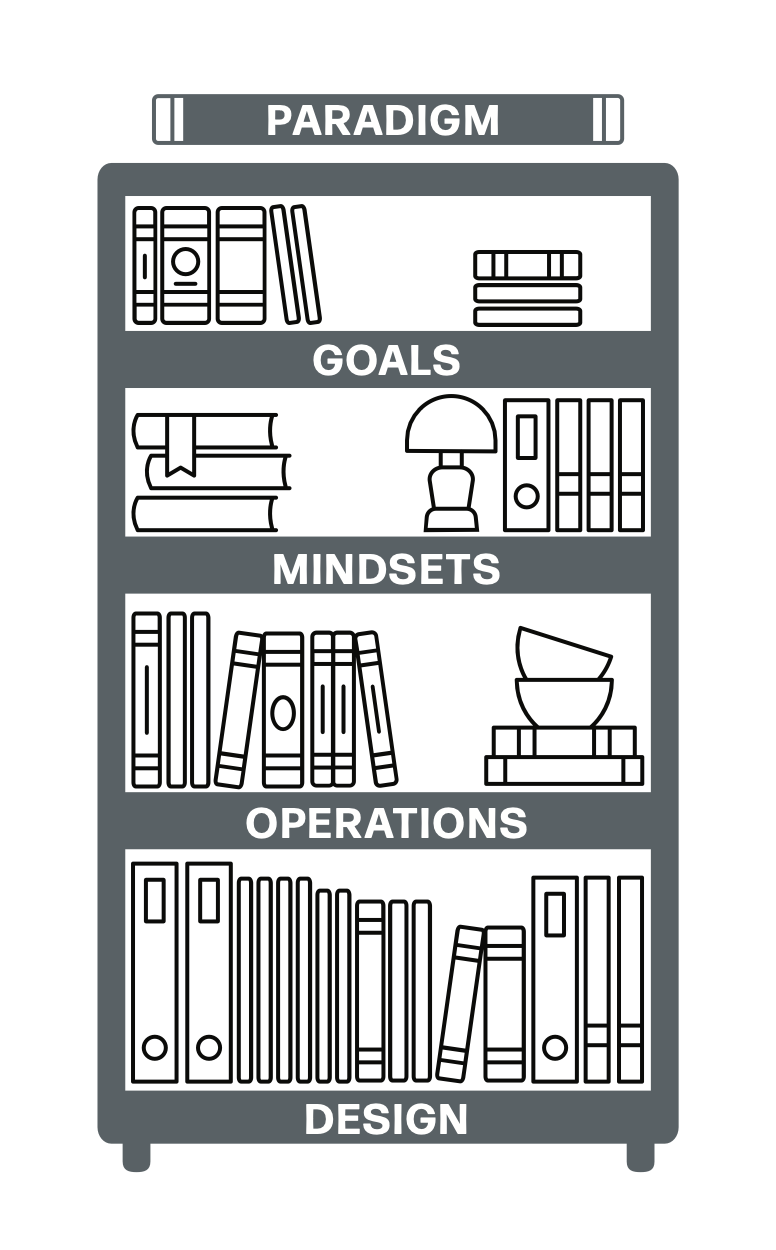Have you every wondered why we make the engineering decisions we do? Why, despite decades of knowledge about the climate and ecological breakdown, we continue to design in a way that causes harm to our life-support systems. To help understand the driving forces behind design decisions, James Norman and I proposed the Systems Bookcase model in ‘the Regenerative Structural Engineer’.
The Systems Bookcase model explained
Imagine a bookcase to house every book that describes how an industry is organised. Now imagine that the books are arranged in order of increasing influence as you go up the shelves. This is the systems bookcase model.

Diagram of the Systems Bookcase as described by Broadbent and Norman in the Regenerative Structural Engineer, 2024.
Drawing on Donella Meadows’s influential essay ‘Leverage Points – places to intervene in a system‘, we propose the following categories for the bookshelves.
1. Design (the bottom shelf)
The foundation of the bookcase is books about the things that get built and made – buildings, infrastructure, products. This is the shelf with the most books, written in the most detail, and by the most authors.
2. Operations
A step higher, this shelf holds the books that guide what we can and can’t design: rules, regulations, guides, planning requirements, strategies etc.
3. Mindsets
This shelf has far fewer books but they are highly influential. They describe the values, ethics and motivations that shape the operations shelf.
4. Goals
Near the top now, the handful of books on this shelf describe the overarching aims of the industry – be that social benefit, profit, security etc.
5. Paradigm (top)
Right at the top, laying flat like the art book that you can’t fit anywhere else, is the place reserved for the paradigm. This is the governing philosophy for the whole system.
How does the systems bookcase apply in your industry? What designs are and aren’t permitted, and why? Are there operational rules, guidance and principles that guide design and what informs these? Which mindsets guide work in your industry? What are the goals – what is everyone setting out to do? And what is the overall philosophy that guides everyone in their work?
These questions are especially important when we consider how to shift to shift to regenerative ways of designing.
Regenerative design – a new goal on the systems bookcase
The concept of regenerative design has gained traction as part of a wider realisation that we are dependent on the health and wellbeing of the ecosystems that support them. When they thrive, so do we; when they struggle to survive, then we do too. This holistic way of thinking is odds with the paradigm of continuous growth – it represents a different paradigm at the top of the systems book case.
The aim of regenerative design is for living and human systems to survive, thrive and co-evolve. We can see these aims as systems goals that are consistent with a paradigm of holism.
The challenge of regenerative design
Placing regenerative design as a goal on the systems bookcase helps us to understand why regenerative design is so difficult to achieve within the current way our projects and industry is organised. It is fundamentally at odds with the guiding overarching paradigm of continuous growth.
But paradigms aren’t forever fixed – over time, one way of thinking gives way to another (see the Three Horizons Model and the Bookcases of Systems Change). The role of the regenerative designer is to collaborate with others to accelerate that change.
Conclusion
The Systems Bookcase is a simple tool for illustrating how different factors influence the behaviour of a system. The model helps us think about the type of interventions we might make, what they might influence and how they might be constrained.
The way the engineering industry is organised in the Global North is consistent with an overarching paradigm of continuous growth. Regenerative Design, by contrast, is consistent a paradigm of holism.
Understanding the Systems Bookcase is a precursor to delving into the Library of Systems Change.
References
Broadbent, O. & Norman, J., 2024. The Regenerative Structural Engineer. London: Institution of Structural Engineers. URL https://www.istructe.org/resources/guidance/the-regenerative-structural-engineer/
Meadows, D., n.d. Leverage Points: Places to Intervene in a System. URL https://donellameadows.org/archives/leverage-points-places-to-intervene-in-a-system/ (accessed 10.3.23).


2 Replies to “The Systems Bookcase model”
Comments are closed.